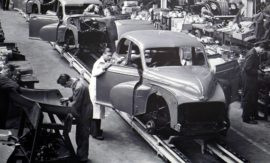Intended learning outcomes: Present setting the parameters of the fire damper. Disclose the number of possible combinations with n parameters as well as an example for number of identical bill-of-material positions.
Let us examine the problem using the example of a fire damper built into a ventilation duct, as shown in Figure 7.3.1.1. In the case of fire, the damper automatically stops the ventilation that would promote the spread of the fire.
Fig. 7.3.1.1 Setting the parameters of the fire damper.
Because ventilation ducts must fit the building, fire damper manufacturers must be able to offer a damper for every conceivable cross-section of “width * height * depth.” To reach flexibility in achieving customer benefit, the damper is manufactured only to customer’s order. Only certain semifinished goods, such as side pieces, strips, and drive kits, are premanufactured in small-sized production according to frequently requested variants. There are approximately 30 to 50 bill-of-material positions. Product features such as damper type, height, width, depth, and type of connection profiles are called parameters.
The product solution space is the combined variety of the customization domains to form a desired commercial product variety.
Therefore, the customer can specify any combination of parameter values of the value domains of the defined solution space. A group of parameters like this determines the type and quantity of required components (such as sheet metal, strip, connecting, and drive materials) as well as the operations with regard to production facilities and setup and run time (or load), and even with regard to description (for example, the number of fastening holes and the distance between holes in the connection profiles). Actually, four types of dampers are offered with widths from 15 to 250 cm and heights from 15 to 80 cm. With measurement increments of 5 cm, there would be 2688 variants (4 * 48* 14). A free combination of parameter values results in a theoretical number of tens of thousands of variants. The number of different dumpers in the practical world reaches thousands.
Let p(i) be the parameter of i (for example, type, width, height, depth, options, accessories) and ∣p(i)∣ ≥ 1 be the number of possible values of the parameter p(i). Figure 7.3.1.2 shows the formula for the number of theoretically possible combinations. Of these, each has a bill of material and a routing sheet and differs — as a whole — from all others. A certain component can, however, be used to build many of these combination possibilities.
Fig. 7.3.1.2 Number of possible combinations with n parameters.
For the fire damper, let p(1) and p(2) be the parameters width and depth. As a semifinished good independent of the other parameters, sheet metal pieces are cut to a width of 800 mm and a depth of 240 mm. This item is used as a component in all bills of material for dampers having a width of 800 mm and a depth of 240 mm. The number of these bills of material is calculated according to the formula in Figure 7.3.1.3.
Fig. 7.3.1.3 Example for number of identical bill-of-material positions.
All bills of material and routing sheets for the product family are similar. Their being nearly identical is typical of this type of production. If you were to keep a bill of material and a routing sheet for every single possible combination of parameter values, the greater part of the stored data would be redundant.
Classical aids to product configuration with the business objects item, bill of material, routing sheet, and work center (see Section 1.2, or as detailed objects in Section 17.2) do not allow the definition and storing of parameters and dependencies.
In such traditional systems, it would be possible to derive the variant from a “parent version” using adaptive techniques according to Section 7.2. However, with very many positions on the bill of material and many operations, this would place a heavy burden on qualified employees. This is not feasible for products with low value added. If, however, bills of material and routing sheets were created from the start in all their possible combinations, e.g., as one-dimensional variant structures (see Section 7.2.2), the multiplicative explosion of quantities of the positions on bills of material and routing sheets to be saved as data would make relocating efforts enormous and unfeasible. Engineering change control (ECC) for these thousands of bills of material and routing sheets would be highly problematic.
Exercise Bike Factory
Course section 7.3: Subsections and their intended learning outcomes

7.3 Generative Techniques
Intended learning outcomes: Disclose the combinatorial aspect and the problem of redundant data. Present variants in bills of material and routing sheets as production rules of a knowledge-based system. Explain the use of production rules in order processing.

7.3.1 The Combinatorial Aspect and the Problem of Redundant Data
Intended learning outcomes: Present setting the parameters of the fire damper. Disclose the number of possible combinations with n parameters as well as an example for number of identical bill-of-material positions.

7.3.2 Variants in Bills of Material and Routing Sheets: Production Rules of a Knowledge-Based System
Intended learning outcomes: Differentiate between design rules and process rules. Explain the concept of design rules or process rules.

7.3.3 The Use of Production Rules in Order Processing: The Parameterized Bill of Material
Intended learning outcomes: Present an excerpt from the parameterized bill of material for the fire damper.

7.3.3b The Maximum Bill of Material and the Maximum Routing Sheet
Intended learning outcomes: Present the maximum bill of material and maximum routing sheet. Identify data storage complexity for the fire damper example. Disclose the use of generative techniques in connection with CAD and CAM as well as in the service industries.
